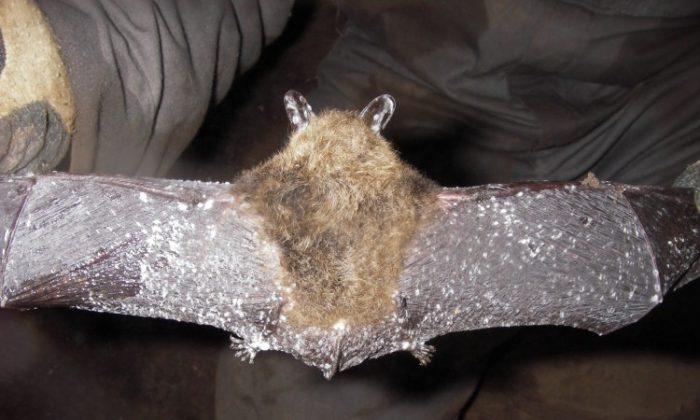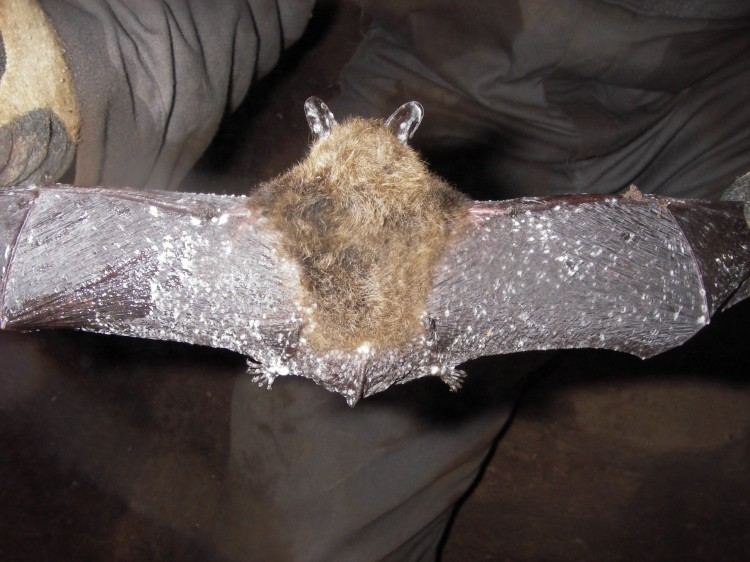A scientist in New Brunswick is sounding the alarm over a deadly fungus that is severely impacting bat populations in the province and could spread across the country.
During an inspection of the bats’ winter hibernation sites in recent weeks, Donald McAlpine, research curator of zoology at the New Brunswick Museum, found that the disease-causing fungus known as white-nose syndrome (WNS) has spread to three new sites.
This is despite the fact that it is still early in the hibernation season and WNS often doesn’t become evident until later in the winter.
McAlpine says the quick spread of the highly contagious disease is worrying and doesn’t bode well.
“There’s great concern that eventually [WNS] will make its way to Western Canada. There’s a very diverse bat fauna in B.C. and other parts of Western North America, so there’s plenty of concern there.”
White-nose syndrome has been decimating bat populations across eastern North America for the past five years, with mortality rates reaching 100 percent at many sites.
U.S. Fish and Wildlife Service biologists and partners estimate that between 5.7 million and 6.7 million bats have now died from the disease.
First documented in New York in 2006, WNS is thought to have originated in Europe and been brought to North America by humans. It has spread quickly to 16 U.S. states as well as New Brunswick, Nova Scotia, Quebec, and Ontario.
The disease appeared in Ontario and Quebec in 2009 but McAlpine made the first Maritime discovery in New Brunswick in March 2011. The one infected site he found housed the largest concentration of hibernating bats in New Brunswick. Of the estimated 6,000 bats in the cave, 90 percent had died.
“It appears that the major vector of the disease are bats themselves, but [we’re] certainly concerned about people spreading the disease,” he says.
Bats with WNS exhibit unusual behaviour during the winter months, including flying outside during daytime and clustering near the entrances of caves and mines where they hibernate.
Loss to Agriculture
McAlpine says the decline in bat populations is particularly concerning because they prey on many pests that attack plants and crops.
“They play much the same role at night as a lot of the insect-eating birds do during the day,” he says.
Bats eat about one-third to one-half of their body weight in insects every night. With over five million dead, lost crop productivity and increased need for insecticides could prove to be costly.
U.S. researchers have estimated that the bat die-off will cost North American agriculture $3.7 billion annually.
Dan Ashe, director of the U.S. Fish and Wildlife Service, says the high bat mortality rates and the loss of their natural pest control abilities poses a severe threat to farms and forests.
“This … illustrates the severity of the threat that white-nose syndrome poses for bats, as well as the scope of the problem facing our nation,” he says.
“Bats provide tremendous value to the U.S. economy as natural pest control for American farms and forests every year, while playing an essential role in helping to control insects that can spread disease to people.”
The New Brunswick Department of Natural Resources is urging recreational cavers to avoid entering caves and mines used by bats for hibernation, especially in areas known to have had incidence of white nose syndrome.
“We don’t want anybody to spread the disease, but we also don’t want to stress the bats which are already highly stressed,” McAlpine says.
The most common species of bat in Canada is the little brown bat, which has also been most affected by WNS.
Bats can live up to 30 years but have a relatively low birth rate—only one young born every year—so scientists have warned that it could take many years for populations to recover.
McAlpine and University of New Brunswick graduate student Karen Vanderwolf have started a multi-year program to track the spread and impact of WNS in News Brunswick’s bats.
“We have a very good pre-white nose database and we’re trying to build on that to get a sense of how fast this disease will be spreading and what its impact will be on bat populations, and it will allow us to track the recovery of populations as well,” McAlpine says.






